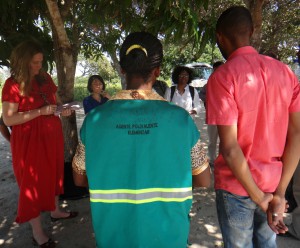
In this guest post, Dr Miriam Taegtmeyer, Senior Clinical Lecturer at the Liverpool School of Tropical Medicine writes for Human Resources for Health on the need for better evidence on the benefits and implementation of close-to-community health provider programs in low- and middle- income countries.
I am currently a member of the Thematic Working Group on Supporting and Strengthening the Role of Community Health Workers in Health System DevelopmentandtheREACHOUTConsortium. REACHOUT is a research consortium working in six countries in Africa and Asia. The Thematic Working Group brings together academics, policy makers and practitioners interested in strengthening the use of evidence on community health workers.
Many countries are rolling out or scaling up the use of community health workers – or close to community providers of health care to try and increase access to health services in line with national and global development goals. These health workers tend to live in the communities that they work in and receive a small amount of training to prevent, diagnose, and treat major illnesses and health conditions.
There is a great deal of promise in these programmes but if they are to meet their full potential we need new knowledge to ensure the safety, support, sustainability, quality, accessibility and equity of services. We also need to build links with both the broader health system and the communities that close-to-community providers serve. Given the need for better information and guidance we are delighted to be partnering with Human Resources for Health on a new thematic series.
To write this post, I asked for the views of our Thematic Working Group members to explain why this thematic series is timely and necessary.
Why are close-to-community providers so important?
The composition and roles of close-to-community providers differ according to context. But all around the world they are playing a crucial role in the delivery of health services. The Red Cross has recently completed a set of case studies on community volunteers which highlighted some of their positive impacts.
“Trained volunteers, from the local community and working in the local community, are well respected and trusted,” says one of the case studies, Monika Christofori-Khadka. “[They] have an immense impact in health prevention and promotion leading to changing health behavior of the local population, particularly regarding maternal and child health and water, sanitation and hygiene.
In some settings health facilities are inaccessible and unreachable, as our colleague Daniel Gemechu of HHA in Ethiopia explains:
“Health facilities remain unreachable due to barriers which are physical (distance), socio-economic and cultural (related to stigma). It is through close-to-community services, delivered by community residents or members who understand the culture, that we can reach and ensure accessibility of the health to the community and get beyond these barriers.”
The embeddedness and cultural understanding of close-to-community providers was a point raised by Licia Limato of the Eijkman Institute for Molecular Biology in Indonesia:
“Close-to-Community providers are the community itself,” she says. “As the people who are already engaged with the community they have more understanding about the traditions and cultural values in the community, this can be seen as the advantage for the government to make lay people receive health messages and health services.”
Close-to-community providers can support the health system in ways that go beyond the provision of information. As Ritu Sharma of the Public Health Foundation of India explains:
“Community health workers form an important link between the community and health system, especially in countries and areas where there is shortage or distribution issues in terms of trained medical staff who do not stay close to the community.”

Why do we need more evidence on close-to-community providers?
There appears to be a resurgence of interest in close-to-community programming. Our colleague Masuma Mamdani, of Ifakara Health Institute in Tanzania suggests that this is likely to increase:
“Given the increasing burden of long term chronic diseases amidst fragile and constrained systems, and with the burden of care shifting to the household level, community health workers are a necessary part of the system in the delivery of health care. But this will only work if they are effectively supported and supervised.”
The renewed interest in close-to-community health providers needs to be underpinned and intensified by a strong holistic evidence base from different contexts. We are still unsure about the best ways to strengthen, sustain and scale up close-to-community services.
No single paper or systematic review will answer all the questions policy makers, practitioners, donors, NGOs and communities may have about how best to strengthen these services. As the Thematic Working Group we need opportunities to support dialogue, interpretation, critiquing and translation of evidence, and sharing of experiences and best practice from different contexts, stakeholders, scales and disciplinary perspectives.
Although our thematic series is focussed in low- and middle-income countries, it is likely to have relevance and resonance beyond these settings. Sara Javanparast, of Flinders University in Australia suggests that:
“Given the increasing trend of migration, growing problem of chronic disease and issues of access and equity particularly amongst disadvantaged groups and also Indigenous people, more evidence is needed to inform health and human resource policies in developed countries.
“What lessons can we learn from successful close-to-community programmes that are transferable in a different context? What are the existing models of close-to-community programmes in developing countries and factors influencing sustainability of programmes? These are kind of questions that we don’t have enough evidence for in more developed countries.”
You can submit a paper by 24th November 2014 to the ‘Close-to-community providers of health care: informing a global agenda’ thematic series by visiting the Human Resources for Health website. The Thematic Working Group have a number of activities planned for the coming months, including several sessions at the Global Symposium on Health Systems Research, contact Faye Moody (Faye.Moody@lstmed.ac.uk) if you would like to learn more.
One Comment